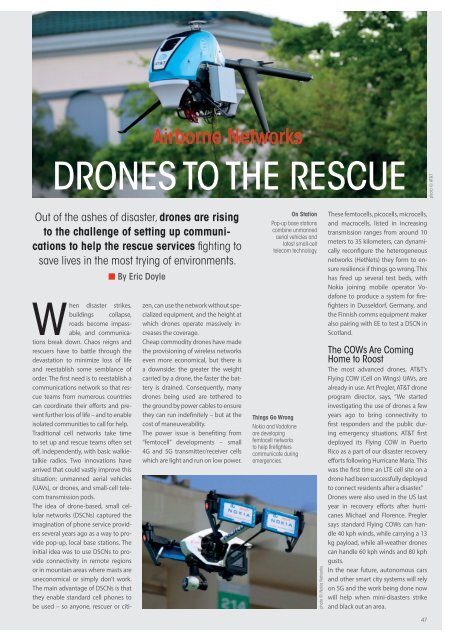Smart Industry 1/2019
Smart Industry 1/2019 - The IoT Business Magazine - powered by Avnet Silica
Smart Industry 1/2019 - The IoT Business Magazine - powered by Avnet Silica
Create successful ePaper yourself
Turn your PDF publications into a flip-book with our unique Google optimized e-Paper software.
Airborne Networks<br />
drones to the Rescue<br />
photo ©: AT&T<br />
Out of the ashes of disaster, drones are rising<br />
to the challenge of setting up communications<br />
to help the rescue services fighting to<br />
save lives in the most trying of environments.<br />
n By Eric Doyle<br />
When disaster strikes,<br />
buildings collapse,<br />
roads become impassable,<br />
and communications<br />
break down. Chaos reigns and<br />
rescuers have to battle through the<br />
devastation to minimize loss of life<br />
and reestablish some semblance of<br />
order. The first need is to reestablish a<br />
communications network so that rescue<br />
teams from numerous countries<br />
can coordinate their efforts and prevent<br />
further loss of life – and to enable<br />
isolated communities to call for help.<br />
Traditional cell networks take time<br />
to set up and rescue teams often set<br />
off, independently, with basic walkietalkie<br />
radios. Two innovations have<br />
arrived that could vastly improve this<br />
situation: unmanned aerial vehicles<br />
(UAVs), or drones, and small-cell telecom<br />
transmission pods.<br />
The idea of drone-based, small cellular<br />
networks (DSCNs) captured the<br />
imagination of phone service providers<br />
several years ago as a way to provide<br />
pop-up, local base stations. The<br />
initial idea was to use DSCNs to provide<br />
connectivity in remote regions<br />
or in mountain areas where masts are<br />
uneconomical or simply don’t work.<br />
The main advantage of DSCNs is that<br />
they enable standard cell phones to<br />
be used – so anyone, rescuer or citizen,<br />
can use the network without specialized<br />
equipment, and the height at<br />
which drones operate massively increases<br />
the coverage.<br />
Cheap commodity drones have made<br />
the provisioning of wireless networks<br />
even more economical, but there is<br />
a downside: the greater the weight<br />
carried by a drone, the faster the battery<br />
is drained. Consequently, many<br />
drones being used are tethered to<br />
the ground by power cables to ensure<br />
they can run indefinitely – but at the<br />
cost of maneuverability.<br />
The power issue is benefiting from<br />
“femtocell” developments – small<br />
4G and 5G transmitter/receiver cells<br />
which are light and run on low power.<br />
On Station<br />
Pop-up base stations<br />
combine unmanned<br />
aerial vehicles and<br />
latest small-cell<br />
telecom technology.<br />
Things Go Wrong<br />
Nokia and Vodafone<br />
are developing<br />
femtocell networks<br />
to help firefighters<br />
communicate during<br />
emergencies.<br />
photo ©: Nokia Networks<br />
These femtocells, picocells, microcells,<br />
and macrocells, listed in increasing<br />
transmission ranges from around 10<br />
meters to 35 kilometers, can dynamically<br />
reconfigure the heterogeneous<br />
networks (HetNets) they form to ensure<br />
resilience if things go wrong. This<br />
has fired up several test beds, with<br />
Nokia joining mobile operator Vodafone<br />
to produce a system for firefighters<br />
in Dusseldorf, Germany, and<br />
the Finnish comms equipment maker<br />
also pairing with EE to test a DSCN in<br />
Scotland.<br />
The COWs Are Coming<br />
Home to Roost<br />
The most advanced drones, AT&T’s<br />
Flying COW (Cell on Wings) UAVs, are<br />
already in use. Art Pregler, AT&T drone<br />
program director, says, “We started<br />
investigating the use of drones a few<br />
years ago to bring connectivity to<br />
first responders and the public during<br />
emergency situations. AT&T first<br />
deployed its Flying COW in Puerto<br />
Rico as a part of our disaster recovery<br />
efforts following Hurricane Maria. This<br />
was the first time an LTE cell site on a<br />
drone had been successfully deployed<br />
to connect residents after a disaster.”<br />
Drones were also used in the US last<br />
year in recovery efforts after hurricanes<br />
Michael and Florence. Pregler<br />
says standard Flying COWs can handle<br />
40 kph winds, while carrying a 13<br />
kg payload, while all-weather drones<br />
can handle 60 kph winds and 80 kph<br />
gusts.<br />
In the near future, autonomous cars<br />
and other smart city systems will rely<br />
on 5G and the work being done now<br />
will help when mini-disasters strike<br />
and black out an area.<br />
47
















